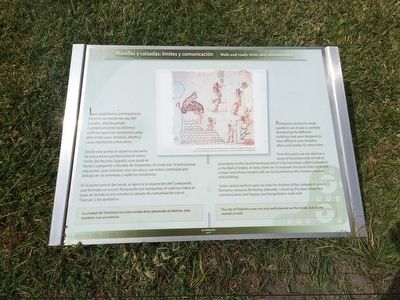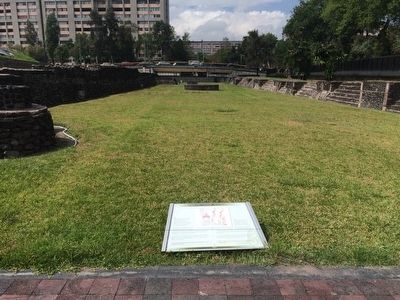Colonia Tlatelolco in Ciudad de México, Mexico — The Valley of Mexico (The Central Highlands)
Walls and roads: limits and communication
Murallas y calzadas: límites y comunicación
Inscription.
Los arquitectos prehispánicos hicieron un excelente uso del espacio, distribuyendo cuidadosamente los distintos edificios que eran destinados para diferentes usos: templos, altares y casas habitación entre otros.
Desde este punto se observa una serie de estructuras que funcionaron como límite del Recinto Sagrado, que quizá se llamó Coatepantli o Muralla de Serpientes. En total son 10 estructuras expuestas, que colindan una con otra y sus restos continúan por debajo de las avenidas y edificios modernos.
En la parte central del norte, se aprecia la separación del Coatepantili, que formaba un acceso flanqueado por banquetas, el cual nos indica el lugar en donde se encontraba la calzada de comunicación con el Tepeyac y Azcapotzalco.
La ciudad de Tlatelolco no solo estaba bien planeada al interior, sino también con el exterior.
Pie de dibujo:
La construcción de cada uno de los templos, edificios y murallas de Tlatelolco, se hizo con una buena planeación arquitectónica y una gran cantidad de trabajadores.
Prehispanic architects made excellent use of space, carefully distributing the different buildings that were designed to have different uses: temples, altars, and homes, to name a few.
From this point, we can observe a series of structures that served as boundaries to the Sacred Sanctuary, which may have been called Coatepantli or the Wall of Snakes. In total, there are 10 exposed structures that come into contact and whose remains still can be found below the modern avenues and buildings.
In the central northern part, we note the division of the Coatepantli, which formed an entrance flanked by sidewalks, indicating the place where the communication and Tepeyac and Azcapotzalco roads met.
The city of Tlatelolco was not only well planned on the inside, but on the outside as well.
English translation of the caption:
The construction of each one of the temples, buildings and walls of Tlatelolco was made with good architectonic planning and a great number of workers.
Topics. This historical marker is listed in these topic lists: Anthropology & Archaeology • Man-Made Features.
Location. 19° 27.117′ N, 99° 8.234′ W. Marker is in Ciudad de México. It is in Colonia Tlatelolco. The marker is at the Tlatelolco Archeological Site on Eje Central near the intersection with Avenida Ricardo Flores Magón. Touch for map. Marker is in this post office area: Ciudad de México 06900, Mexico. Touch for directions.
Other nearby markers. At least 8 other markers
are within walking distance of this marker. Momoztli: a neighborhood altar (within shouting distance of this marker); Tzompantli altar (“flag of heads”) of the north (within shouting distance of this marker); 50th Anniversary of the Treaty of Tlatelolco (within shouting distance of this marker); Battle of Tlatelolco (within shouting distance of this marker); Favor request…and talent for the gods (within shouting distance of this marker); The Reign of Cuauhtemoctzin (within shouting distance of this marker); The Great Base: findings upon findings (within shouting distance of this marker); Coyolxauhqui: The dismembered goddess (within shouting distance of this marker). Touch for a list and map of all markers in Ciudad de México.
Credits. This page was last revised on April 17, 2020. It was originally submitted on January 4, 2016, by J. Makali Bruton of Accra, Ghana. This page has been viewed 275 times since then and 4 times this year. Photos: 1, 2. submitted on January 4, 2016, by J. Makali Bruton of Accra, Ghana.

